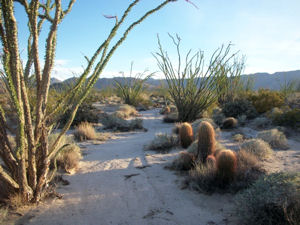
by Terry Weiner
August 31, 2012 (San Diego)--Ocotillo California is an apron of desert fanning out broadly from the base of the rugged Jacumba and Inkopah Mountains, ninety miles east of San Diego and 60 miles west from Yuma Arizona. After winding down 16 miles of Interstate 8 from the agricultural town of Jacumba at 3,000 ft. to the desert floor at 500 ft., you will be treated to a view of a spectacular and relatively uncluttered Colorado Desert landscape. On a rare clear day, you can see the blue of the Salton Sea about 40 miles away. Mexico is just south on the other side of the Jacumba Mountains.
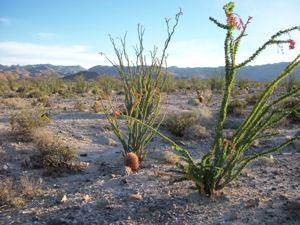
The Resources:
The Ocotillo desert is an integral part of the Yuha Basin, a large portion of which is designated as an Area of Critical Environmental Concern (ACEC) and managed for the protection of the rich Native American and geological resources. The Yuha ACEC protects the Yuha geoglyph, the De Anza Historic Trail, the Crucifixion Thorn Natural Area, and the Yuha Well. Over thousands of years, many Native American tribes have traveled through the Yuha Basin, leaving behind geoglyphs, ceremonial sites, cremation sites, and thousands of lithic and other artifacts.
The Ocotillo desert is a part of the larger Sonoran Desert with summer temperatures up to 120°F and with less than 3 inches of annual rainfall. Elevations range from approximately 1,500 ft above mean sea level to 300 ft, generally decreasing from the west to the east. The area closest to the mountains is a broad alluvial fan with an intricate system of drainages. Robust populations of smoke trees, cats claw, and desert willows reside in some of the long, deep washes. This desert has wonderful desert scrub assemblages, and in the spring, scores of species of desert annuals sprout. Colorful desert pavement coats the high places between washes. Most stunning are the expansive forests of ocotillo throughout the area. Several endangered or threatened species make this desert home as well.
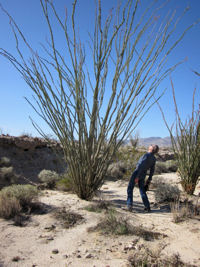 The tiny community of Ocotillo/Nomirage is nestled in the Ocotillo desert along both sides of Interstate 8. With around 400 residents Ocotillo has only one gas station, one locally owned convenience store, the Lazy Lizard Bar and Grill, an off-road vehicle rental place, a very small post office, a community center and park, and a small fire station. Ocotillo is a quiet place. The neighborhoods are dense with native desert trees and shrubs, and there is not a lawn in sight. The citizens chose Ocotillo for the desert dark skies, the broad vistas, for the proximity to wildlife, and for peace and quiet and a slow pace. People bought property on the outer fringes of town believing that their desert would be protected and their quality of life ensured.
The tiny community of Ocotillo/Nomirage is nestled in the Ocotillo desert along both sides of Interstate 8. With around 400 residents Ocotillo has only one gas station, one locally owned convenience store, the Lazy Lizard Bar and Grill, an off-road vehicle rental place, a very small post office, a community center and park, and a small fire station. Ocotillo is a quiet place. The neighborhoods are dense with native desert trees and shrubs, and there is not a lawn in sight. The citizens chose Ocotillo for the desert dark skies, the broad vistas, for the proximity to wildlife, and for peace and quiet and a slow pace. People bought property on the outer fringes of town believing that their desert would be protected and their quality of life ensured.The Problem:
Enter the U.S. government, climate change, the Energy Policy Act of 2005, the American Recovery and Reinvestment Act of 2009, President Obama’s decision to subsidize renewable energy development across wide swaths of the American west, and Secretary of the Interior Ken Salazar’s plan to create a process for fast-tracking development of remote, industrial-scale energy projects on public lands.
Enter in 2009 the Pattern Energy Group LP (offices in San Diego, San Francisco, Houston, NY and Toronto). Pattern develops, constructs, owns and operates renewable energy, particularly wind projects and transmission lines in the U.S., Latin America, and Canada. As stated on their web site, their company’s full development pipeline exceeds 4,000 MW of renewable energy and transmission lines.
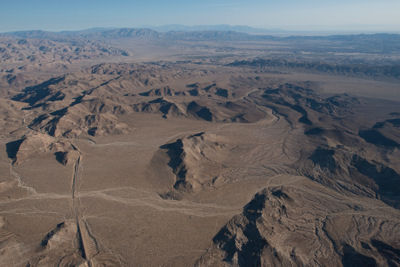 The Ocotillo desert can be a windy place, at least during several months of the year. Does that make it a good place for an industrial wind project? Is there sufficient documentation that there is enough wind to power 130,000 homes in San Diego? The Department of the Interior, Pattern Energy, SDG&E (Sempra Energy), and Imperial County think so. Thus, between 2009 and 2011, Pattern, its consultants, and the BLM crafted an EIR/EIS (Environmental Impact Report/Environmental Impact Statement) and BLM Plan Amendment for a 12,400 acre, 20-square-mile industrial wind turbine project in the Ocotillo desert. In 2011, Pattern Energy obtained a power purchase agreement with SDG&E, whose Sunrise Powerlink transmission line runs through the project area. There will be 112 turbines, each 450 feet tall (picture 40-story buildings), a permanent operations center, a switchyard for SDG&E, a cement batch plant, miles of underground cable, and at least 42 miles of roads to send energy 90 miles to San Diego, losing 6-7% of the electricity along the route. None of the electricity will stay in Imperial County.
The Ocotillo desert can be a windy place, at least during several months of the year. Does that make it a good place for an industrial wind project? Is there sufficient documentation that there is enough wind to power 130,000 homes in San Diego? The Department of the Interior, Pattern Energy, SDG&E (Sempra Energy), and Imperial County think so. Thus, between 2009 and 2011, Pattern, its consultants, and the BLM crafted an EIR/EIS (Environmental Impact Report/Environmental Impact Statement) and BLM Plan Amendment for a 12,400 acre, 20-square-mile industrial wind turbine project in the Ocotillo desert. In 2011, Pattern Energy obtained a power purchase agreement with SDG&E, whose Sunrise Powerlink transmission line runs through the project area. There will be 112 turbines, each 450 feet tall (picture 40-story buildings), a permanent operations center, a switchyard for SDG&E, a cement batch plant, miles of underground cable, and at least 42 miles of roads to send energy 90 miles to San Diego, losing 6-7% of the electricity along the route. None of the electricity will stay in Imperial County.The Ocotillo Wind Energy Facility is a graphic example of what’s wrong with the federal government’s current policy of fast-tracking so-called renewable energy projects on public land.
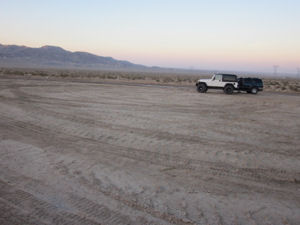
According to the Final EIS/EIR, this project is inconsistent with the BLM Yuha Desert/West Mesa Visual Resource Class Three designation, which requires that a project or action partially retain the existing character of the landscape. This project would introduce structurally prominent industrial features into an otherwise natural landscape adversely affecting visitor experiences in the Anza-Borrego Desert State Park and adjacent real property. The project is inconsistent with Imperial County’s Conservation and Open Space Element. It is incompatible with the Ocotillo/Nomirage Community Plan, which is designed to protect the community resources including its sole source aquifer and the community quality of life from commercial and industrial development. The project is also inconsistent with the California Desert Conservation Area (CDCA) plan which designates the Ocotillo desert area as Class L Limited Use in order to provide for “lower-intensity, carefully controlled multiple use of resources, while ensuring that sensitive values are not significantly diminished.”
Despite these inconsistencies in land use planning, injustices to Native American sacred sites, injustices to the community of Ocotillo; despite thousands of pages of testimony and documentation of inadequacies in the draft and final EIS/EIR; despite formal protests of the final document and the CDCA Plan Amendment; and despite testimony from several tribes at public hearings; still Secretary of the Interior Ken Salazar issued the Record of Decision on May 11 2012 approving the CDCA Plan Amendment and the final Environmental Impact Statement.
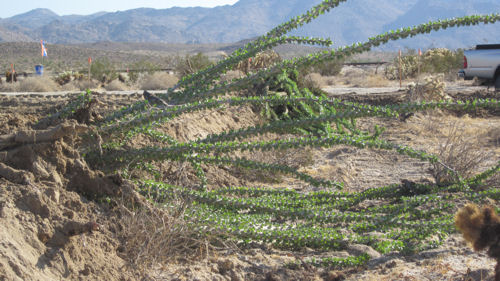 The damage to the Ocotillo desert is underway. As of August 12012, Pattern Energy contractors have scraped nearly 50 of 112 planned, 2-acre turbine pads and have bladed and graveled dozens of miles of roads, some as wide as 110 feet. Additional habitat disturbance from trenching for underground cables has begun. Surface hydrology has been altered by newly carved roads and huge dirt berms that blocked the flow of washes during a July 13th rain event. Entire sections of the ocotillo forest have been plowed down; millions of gallons of water have been sprayed to suppress dust. In addition to noise, high intensity night lighting and destruction of their cherished desert plants and animals, local residents will be exposed to documented health problems caused by turbine noise, shadow flicker, infrasound, and stray voltage. There is also the possibility of an increased incidence of Valley Fever, a spore documented to live in areas of disturbed soil in Imperial County and released by further soil disturbance.
The damage to the Ocotillo desert is underway. As of August 12012, Pattern Energy contractors have scraped nearly 50 of 112 planned, 2-acre turbine pads and have bladed and graveled dozens of miles of roads, some as wide as 110 feet. Additional habitat disturbance from trenching for underground cables has begun. Surface hydrology has been altered by newly carved roads and huge dirt berms that blocked the flow of washes during a July 13th rain event. Entire sections of the ocotillo forest have been plowed down; millions of gallons of water have been sprayed to suppress dust. In addition to noise, high intensity night lighting and destruction of their cherished desert plants and animals, local residents will be exposed to documented health problems caused by turbine noise, shadow flicker, infrasound, and stray voltage. There is also the possibility of an increased incidence of Valley Fever, a spore documented to live in areas of disturbed soil in Imperial County and released by further soil disturbance.The Solution:
Pattern Energy’s massive industrial Ocotillo wind turbine project demonstrates the need for people who support renewable energy to work with local, state, and federal policy makers to shift tax credits, low cost loans, and other incentives from large, for-profit corporations to home and business owners. Rooftop solar and distributed generation in cities and towns provide a cleaner, cheaper, and faster solution to combating climate change. According to the California Public Utilities Commission, PG&E now pays less for moderate-sized rooftop solar power ($114/MWhr) than for wind energy ($118/MWhr).
Given the unreliability of the wind resource and the vast environmental and other costs of wind energy’s harmful impacts, it behooves us to press our policy makers for a reasonable system of feed-in-tariffs for local rooftop solar that sends energy into the grid. If we are to protect our southwest deserts from further taxpayer-supported corporate land appropriation for private profit, the Federal Production Tax Credits for large-scale wind projects must not be re-instituted in 2012.
Reprinted with permission from the Desert Report, a publication of the Sierra Club CNRCC Desert Committee, at t http://www.desertreport.org/
Terry Weiner is the Imperial County Conservation and Projects Coordinator for the Desert Protective Council. (www.protectdeserts.org), a co-founder of Solar Done Right (www.solardoneright.org), and Chair of the CNRCC ORV Issues Task Force and the Alliance for Responsible Recreation. Terry grew up in western Massachusetts, but has lived in San Diego since 1979 and spends as much time hiking, camping and botanizing in the southwest deserts as she can manage. She can be reached at terryweiner@sbcglobal.net; (619) 342-5524.








Comments
More on Changing the environmental laws for big business
I have more to add about the latest proposals or law changes by USFWS in the Federal Register. ( Federal Register / Vol. 77, No. 165 / Friday, August 24, 2012 / Proposed Rules) as big business exploits the public's land and resources. The are going to shorten the public comment period. Developers have years to get their bogus documents together before they ambush communities with their projects. Now they think it is reasonable for the good people to have only 60 days to mount their battle. They also have virtually no time to generate support ot conduct any reasonable studies exposing problems. Proposals by USFWS in the Federal Register. ( Federal Register / Vol. 77, No. 165 / Friday, August 24, 2012 / Proposed Rules) .
What will change as a result of the final regulation?
The benefit of this change in the regulations is to provide the public a complete view of the rulemaking
process as it relates to designation of critical habitat. Current practice allows for a second public
comment period on a proposed designation of critical habitat when the draft economic analysis is made
available after the designation of critical habitat is published. When finalized, our process under the
revised regulation would not provide for a second comment period as the draft economic analysis
would be available when the proposed rule is published. This change would reduce the public
comment period on the proposed rule form a current total of 90-days to 60-days. The Services will still
be required under the ESA to finalize a designation of critical habitat within one year of the proposal.
Obama needs to go and so do others like Gov.Brown
Your enemy is not just President Obama and Governor Brown because they are only working for a pool of international investors. None of which really cares what happens at Ocotillo. I will also tell you the wind industry has huge plans for the public's desert land. I know this by the bogus studies that are being generated and the laws they are actively rewriting. I see a very clear foundation of fraud being laid for this expansion. Some of this foundation is from the latest proposals by USFWS in the Federal Register. ( Federal Register / Vol. 77, No. 165 / Friday, August 24, 2012 / Proposed Rules) . From what is written below it is clear the wind industry is going after the wind resources in the critical habitat of several endangered species. One of these areas is in the critical habitat for the California Condor around Tejon Ranch.................... We, the U.S. Fish and Wildlife Service (FWS) and the National Marine Fisheries Service (NMFS) (collectively referred to as the ‘‘Services’’ or ‘‘we’’), propose to revise our regulations pertaining to impact analyses conducted for designations of critical habitat under the Endangered Species Act of 1973, as amended (the Act). These changes are being proposed as directed by the President’s February 28, 2012, memorandum, which directed us to take prompt steps to revise our regulations to provide that the economic analysis be completed and made available for public comment at the time of publication of a proposed rule to designate critical habitat. (b) Prior to finalizing the designation of critical habitat, the Secretary will consider the probable economic, national security, and other relevant impacts of the designation upon proposed or ongoing activities. The Secretary will consider impacts at a scale that the Secretary determines to be appropriate, and will compare the impacts with and without the designation. Impacts may be qualitatively or quantitatively described. (c) The Secretary has discretion to exclude any particular area from the critical habitat upon a determination that the benefits of such exclusion outweigh the benefits of specifying the particular area as part of the critical habitat. In identifying those benefits, in addition to the impacts considered pursuant to paragraph (b) of this section, the Secretary may consider and assign the weight to any benefits relevant to the designation of critical habitat. The Secretary, however, will not exclude any particular area if, based on the best scientific and commercial data available, the Secretary determines that the failure to designate that area as critical habitat will result in the extinction of the species concerned. In other words "The Secretary" will be able to do whatever he wants.
desert lands - protests filed
Jim - You may not have seen this yet, but several environmental groups are challenging the federal government's new plans for fast-tracking opening vast tracts of deserts up for large-scale solar:
http://www.eastcountymagazine.org/node/10908
No one with a conscience
No one with a conscience could fail to be horrified by the havoc that's now being wrecked all across the desert in the name of "renewable energy."
What a cruel joke: Hundreds of thousands of acres of beautiful wilderness destroyed forever. And for what? A) A form of power utterly inadequate to our needs; and, B) One that will do NOTHING to achieve its ostensible goal, i.e., a cleaner environment.
He sold himself as a "green candidate," but President Obama has turned out to be anything but. He is, in fact, the greatest threat to the wilderness we've ever seen.
http://www.youtube.com/watch?v=7D8rT2ttoS0
Forests are being destroyed for wind turbines, too. See photos:
http://www.alaskadispatch.com/slideshow/photos-fire-island-wind-project This is the devastation from just the first of many wind turbines planned on Fire Island off Anchorage, Alaska.
How much C02/greenhouse gasses were being absorbed by the trees destroyed for this project? Why isn't our government demanding to see proof that a project actually reduces greenhouse gas emissions; I suspect this project actually makes them worse. The enviornmental damage is horrific and just imagine the poor wildlife on an island soon to be covered by turbines producing infrasound, noise, flashing lights, and possibly stray voltage too.
Romney opposes renewing the wind tax credit. However he is no friend of protecting the environment either. He wants to open up public lands, even National Parks, for oil, gas and fracking.
I would like to see national news reporters and citizens pressing leaders in both parties to make environmental protection and saving our public lands a priority, as well as discourating wind turbines in environmentally sensitive areas. Solar on roofs is by far the safest, cleanest and least destructive option. Some solar farms could be built but not in the desert tearing up habitat -- instead put them on contaminated lands as the EPA has suggested. We can also support vertical access turbines in the already built environment- at homes and businesses and schools, since they are small-scale and don't kill birds or destroy habitat.